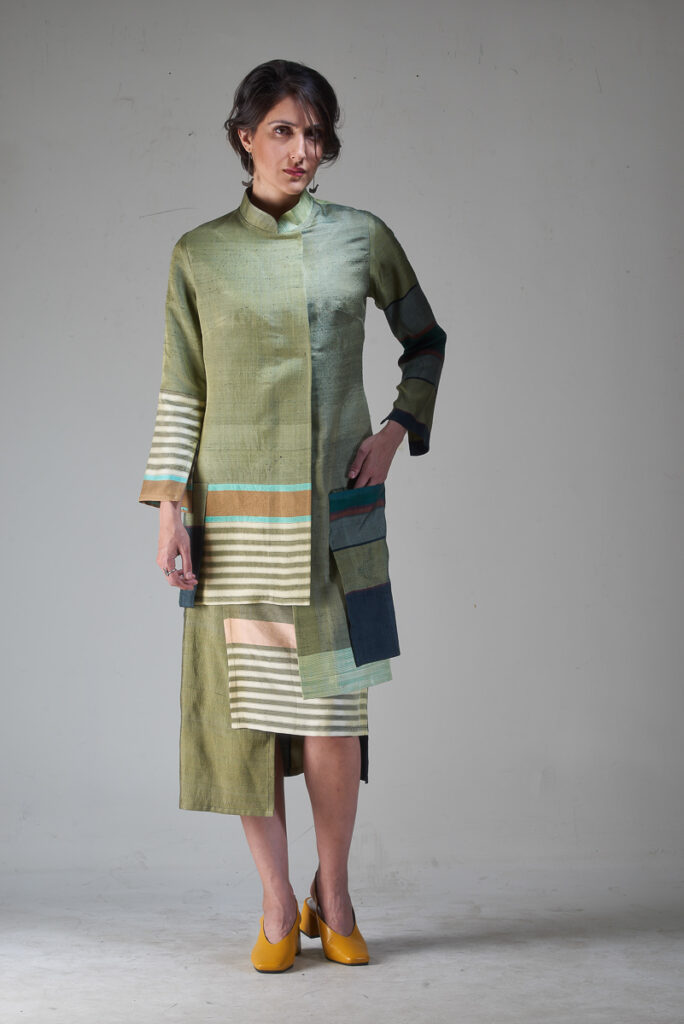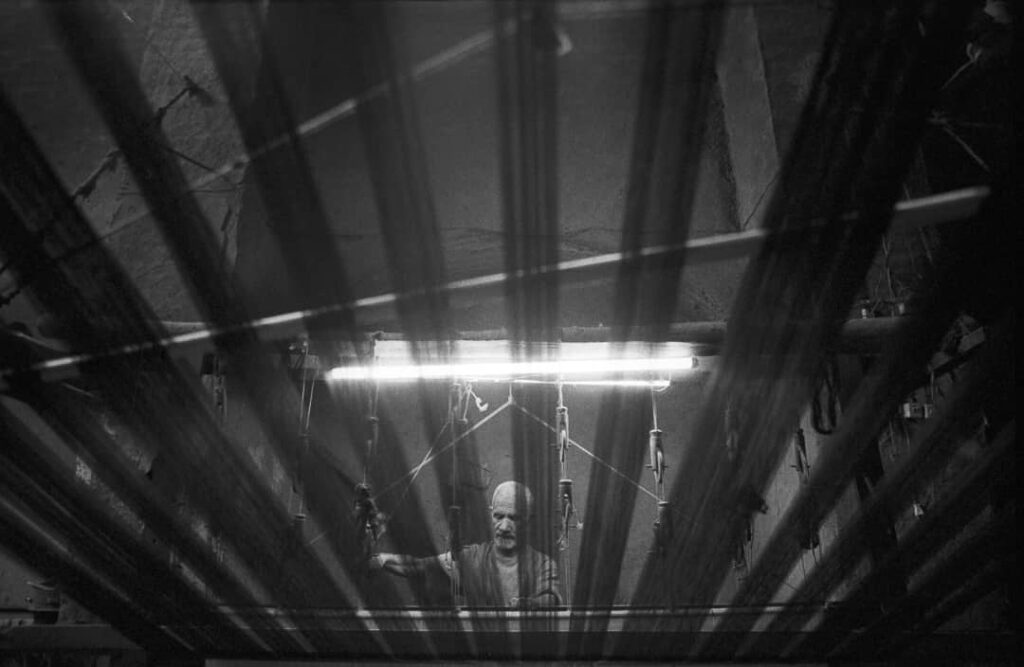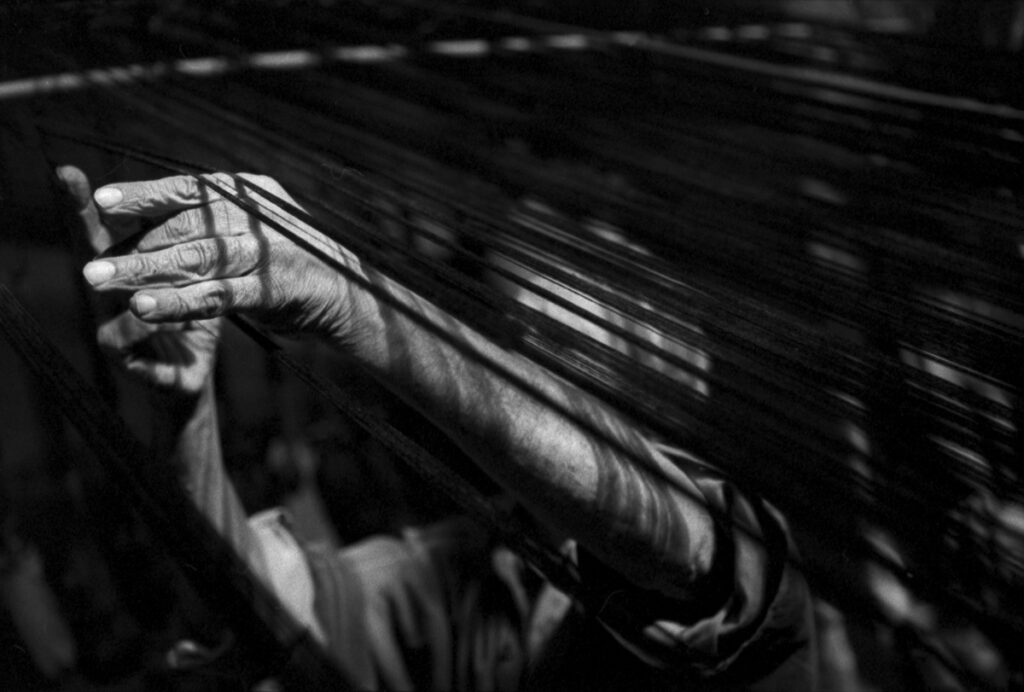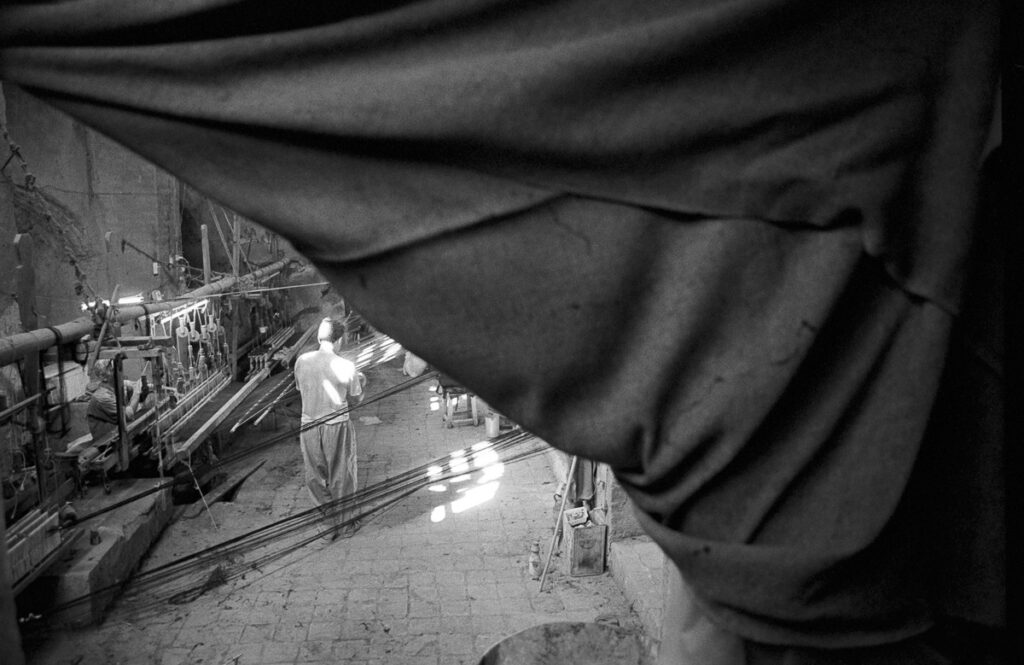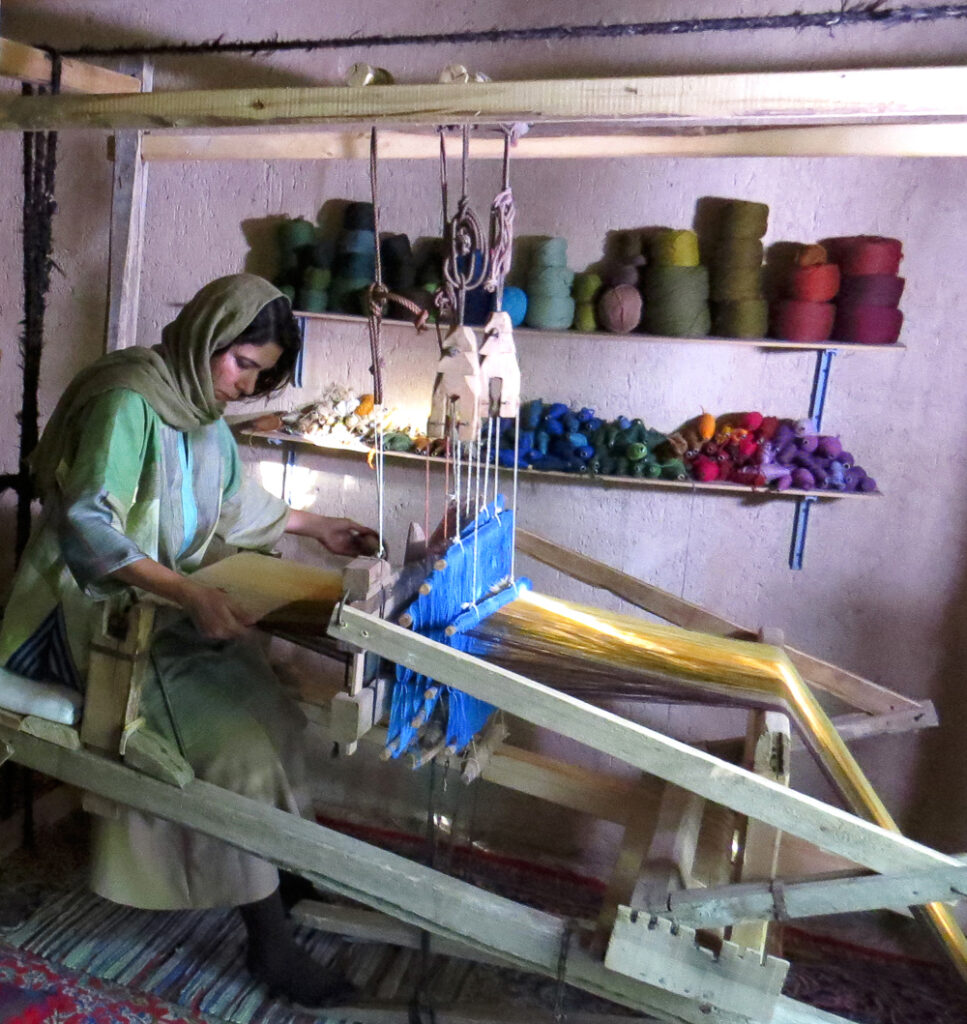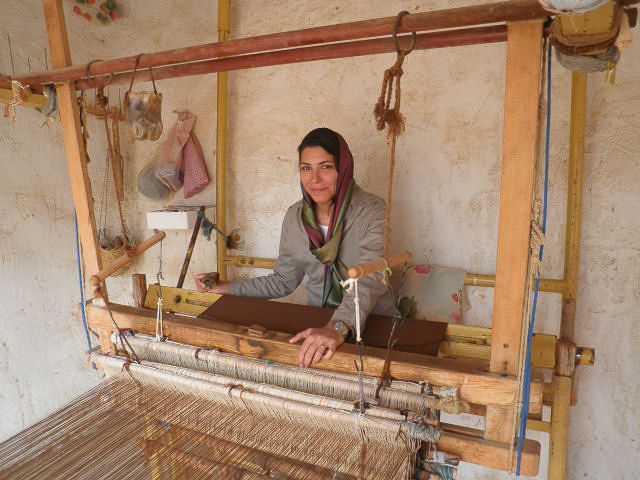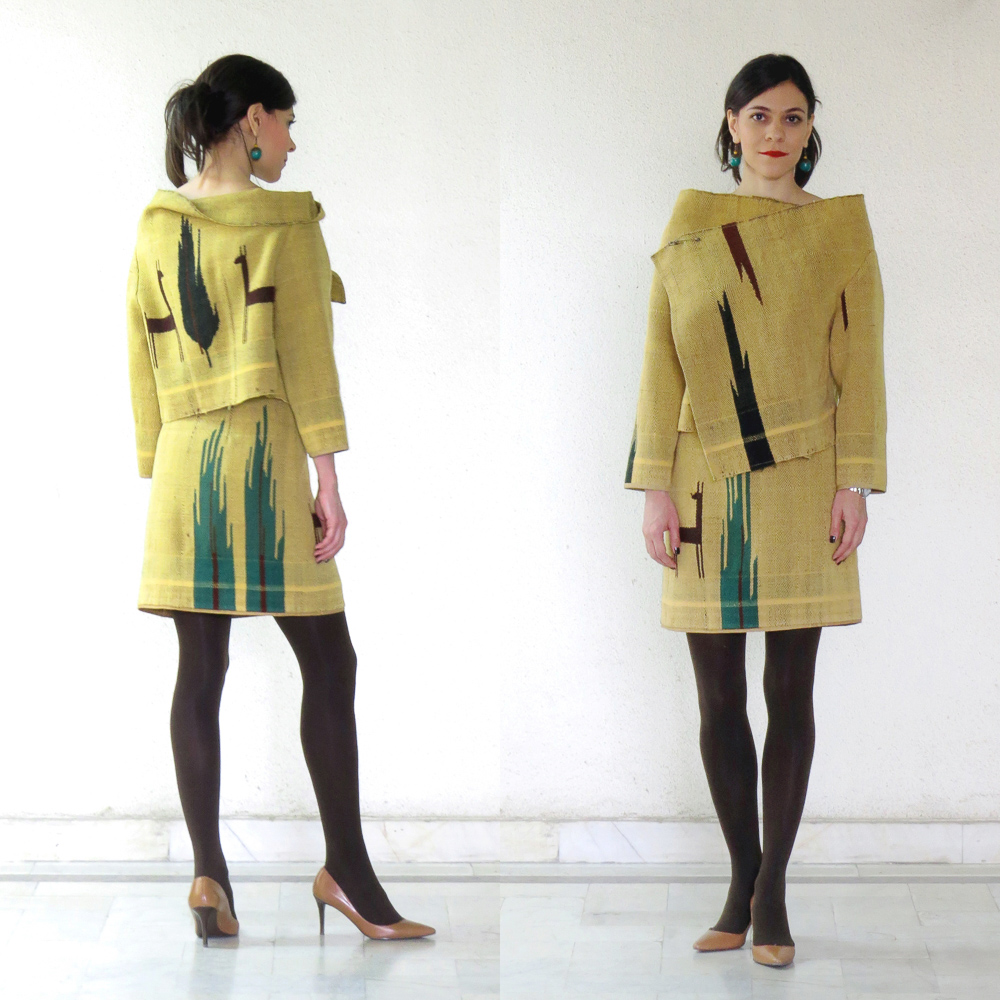Our February laurel goes to Iranian weaver and fashion designer, Azadeh Yasaman, who seeks to give new life to the ancient beauty of her culture.
I am Azadeh Yasaman Nabizadeh; a textile and fashion designer, a weaver, a researcher and a teacher. I am the owner of A-Y brand; we make Persian hand-woven fabrics and clothes and are committed to sustainable methods of production.
To briefly tell you what motivated me in my work, I should say that I have always followed my interests. When we look for the roots of our interests, we usually look back on our childhood memories. I remember that like many other little girls, I used to make dresses for my dolls or play with balls of yarn and, as I grew up, this pastime became a continuous fascination to me.
As a teenager, I was deeply captivated by colours and patterns, so I pursued art academically at Tehran University of Art.
The weaving loom was a new instrument to me, something I chose to express my designs with. I started to weave my canvas and wore it on bodies instead of walls. Apart from the attraction and charm of the work itself, its antiquity made this art a sacred subject for me. I learned the history and mythology of fabrics and clothes. Weaving became like wandering in a world of dreams and fantasies. Learning its history turned it into a kind of ritual, and opened a window to an old profession from the world of myths and our ancient roots.
Like the beginning of this craft in the world, I started my work with its simplest method. I wrapped the woven cloths with no cuts and seams around my body.
My textiles are made in the same traditional technique of our predecessors, but I have modified the ordered structure of warps and monochromic arrangement of wefts and created a fabric, with wave-like shades. I use a variety of materials for my works; from new materials—like polyester—to wool, cotton and ribbon and even wire and stone.
Until 2005, weaving was a colourful experiment for me and I had no intention other than enjoying and exploring the work while admiring its beauty.
Ali Khatib-Shahidi my husband and co-worker brought a more serious and professional aspect and goal to my work. We decided to revive the traditional cloth-weaving network. We started to travel around the country, but seeing the people who neither remembered nor believed in their past, was a real disappointment that made us return home.
Beside my hand-woven textiles, which were young, noisy and lively, I longed for fabrics with roots in the history and geography of Iran. Traditionally-made fabrics were low in quality; weaving workshops were mostly wrecked and weavers were unmotivated, weary and old.
In my disbelief, but Ali’s perseverance, he convinced the owners of a silk-weaving workshop in Kashan to work with us. They did not want to change their old routines. I wanted those ancient hand-weaves to have a modern spirit, while being loyal to their traditional features. Therefore, I introduced a sort of irregularity and disorder in arrangement and colours of their well-ordered traditional structure… sort of like what has happened in our lives and beliefs.
- Kashan Silk Workshop
- Kashan Silk Workshop
- Kashan Silk Workshop
In each of our orders, Ali tried to promote the quality of one of the stages of the work. Improving the quality of organic and natural dyeing, increasing the density of fabrics, reviving Abresh and Ikat dyeing techniques, reinstating the four-harnessed loom and using colourful warps instead of the traditional black warp yarns were parts of our plans that Ali has accomplished by the help of traditional workmen.
I make different collections inspired by history, nature, culture or myths, like Woven-wears, Garments, Landscapes and Soo-va-shoon. Multi-pieces is one of these collections, which is divided into two silk and cotton sub-collections.
Collections are not created in a single manner. Sometimes it is a process that must develop and come to a conclusion. Sometimes it strikes just like the way lightning suddenly flashes and forms the initial core. The latter usually happens during a journey. This journey can just be a walk or getting to know an unknown place or travel through historical books, poetry or mythology. Anyhow, different resources—literature, images and pictures as well as spiritual perceptions—have a tremendous effect.
I moved on with the history of clothing. From the middle of the Parthian Empire era (Persian Empire from 247 BC to 224 AD) until the thirteenth century, the inner clothing and outer garment were both made of pieces of square and rectangular cloths. They were loose and oversized, thus everybody could put on the other person’s clothes. I started to weave pieces of textiles in harmony with the body in proportion to our ancestral clothing and to prevent the unfamiliar cuts from tearing down its ancient beauty. Cuts are only made out of necessity.
- Azadeh Yasaman at work
- Azadeh Yasaman at work
- Ali in Kashan Silk Workshop
My silk Multi-pieces Collection has an impression from the past, while the irregularity of its measurements reveals our current conditions. They are geometrical as if square shapes have been perfectly blended into a whole which looks so elegant and harmonious regarding the colour match. The play with proportions is so amazing as well; longer and shorter pieces combined into a single dress.
To start weaving, you must first loom the warp yarns, which determine the type, colour and size of the fabric and remain unalterable till the end. The warps form the structure of the fabric and must be designed correctly. Every minor mistake can slow down the process. Warps are like the basis of being; like the fact that I am an Iranian woman, with unchanging characteristics. But, wefts are like thoughts, experiences and memories; changing or repeating… and can alter the design or colour of the fabric in every move. They are like moments of life, which repeat, but are always fresh and new!
From the early days of history, ethnic arts have been evidence of their age. Arts move like waves and every rise and fall shape a certain style or school. Today, the world is in a rush, as if it is always late! The reason for the extinction of many traditional arts is because their production lacks the spirit of time, as if everything is the same as it was! The art becomes the repetition of the past and short of today… a cliché! I am not looking for the meaning of today in the ruins of the past, I am carrying the bundle of our culture on my shoulder, in order not to find tomorrow empty.
In the modern world, every individual has gathered the whole history and geography of the world in them. It is said that modernity has penetrated into individuals’ genetic code and turned into mankind’s heritage! Every civilisation that does not follow its course will be ruled out of the path, in which the world is moving. Every day, many traditional clothes, games and languages are forgotten and only those innovative civilizations remain that can give their lives a concept, consistent with their values. The cultural wealth, of which we are proud, is not just a word in a dictionary! If we want to keep this beating heart alive, we have to make a move.
For example, in 2008 and in one of our travels to Kordestan Province, we saw Mowj fabrics in a shop. They were formerly used as woollen blankets, but not anymore! It was like meeting a thousand-year-old ancestor; old, weary and forgotten. I found them the most beautiful fabrics for warm winter clothes and made various models of coats, skirts, vests and winter coats. Since then, I’ve been fascinated by their patterns, designs and colours and their variety has always amazed me. I wanted to learn how to weave Mowj and we headed for Kordestan only to find it a forgotten craft.
We spent three years in one of the villages of this region. The kind-hearted villagers were sceptical about us and wondered what treasure we were looking for and which piece of land we would dig up. They did not believe that our treasure lay in their hands and we would only dig into their souls to find a clue about the mystery of weaving.
Crafts were passed on to us during thousands of years and we passed them on to automated machines. Our generation is witnessing the extinction of traditional master craftsmen who have no trainees and will take away our living heritage with their demise. I hope we can pass on our culture to the next generation so as not to see the future empty of the past.
When we started our path, there were only a few hand-weavers and it was our dream to see them grow in number. Horizon changes when you’re in the move and our dreams have changed as well. I am very happy that today, numerous weavers have functioning workshops all around Iran and now, everyone knows many weavers.
Our search for silkworm breeding/sericulture industry led us to Golestan Province, where silk weaving craft has a long history; however, we found it a forgotten craft in this region as well. Since 2016 and after many trips for field studies and researches, we chose a village to start our project. We manufactured weaving looms, set up workshops, revived forgotten weaving techniques and taught them to a number of villagers and inspired them to work. Now, with the collaboration of those villagers, we weave textiles with natural yarns of wool, cotton and silk and dye them with natural colours and traditional methods. We support agriculture, animal husbandry and rural crafts as well as social and environmental development. Large areas of forests have been cut down in this region. We intend to plant white mulberry trees, breed silkworms, spin the silk cocoons and weave the silk yarns into clothes. We want to wear those forests to let them live again.
I do hope that all of us can move towards creating a better life, for everyone, every day everywhere.
You can visit Azadeh’s website www.azadehyasaman.com and follow her @azadehyasaman.

